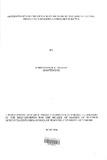| dc.description.abstract | Over the last decade or so, the agricultural sector, with the exception of horticulture,
experienced low and declining productivity in terms of export earnings, employment
creation, food security, household farm income and provision of raw materials for the
agro-processing industries. Despite the positive growth in the horticulture sub-sector, the
horticulture export business's future does not appear bright due to increased competition
from other upcoming countries in the East, Central and West Africa; introduction of
stringent new quality standards and legal requirements in addition to the existing
financial and technical barriers in the industry's small and medium enterprises (SMEs) to
upgrading their product lines and management systems. A difficult challenge under the
EUREPGAP quality standards is ensuring the application of good agricultural practices
(GAPs) particularly among the small holder farmers. The need to address these
challenges places heavy demand on the institutional resources.
This study was conducted with the objective of assessing the important factors that
influence the decision to source for credit facility, the level of credit facility demanded
and the influence demographic factors have on demand for credit within the horticultural
products' exporting companies in Kenya. According to the Horticultural Crops
Development Authority (HCDA) (2004), there are 205 active exporters of horticultural
products from which a sample of fifty finn:~ were randomly selected .
Data was collected through questionnaire method. The questionnaires were administered
through the "drop and pick up later" method while courier services were used for
delivering the questionnaires in case of firms outside Nairobi. The response rate was 60%
which was considered adequate for the study. The assessment on the relative importance
of factors influencing demand for credit in the horticultural products exporting firms was
done on a scale ranging from a score 1= not important to a score 5= very important.
The research study revealed a high demand (72.4%) for credit finance in the horticultural
products exporting businesses. However, out of the total short and long term loans
applied for, 49% were successful while 51% were not. About 56% of the companies
which had never applied for credit facility financed their businesses through partnership
arrangements, 33% through self finance and 11% through financial support.
The study results showed that the factors that the sample firms considered very important
in influencing their decisions to source for credit finance were business expansion,
airfreight charges for C&F orders, compliance with the new market standards and
regulations, investing in IT for market information, investing in value addition to address
customer needs, venturing into new markets, ensuring HACCP standard compliance,
investment in market intelligence services and produce handling facilities. Other factors
rated as important in influencing credit facility demand were installation of cold storage
facilities, financing produce purchase, installation of irrigation system, and prompt
payment of taxes. From the analysis of factors in the value chain it was evident that most
of the ratings throughout the value chain were perceived to be either "very important" or
"important" This is a further indication of high credit facility demand by export
businesses in the horticulture sub-sector.
The only demographic factors that had a significant relationship on demand for credit
were the age of the business and the period the firm had been exporting horticultural
products. The two factors are time based and thereby suggesting that, most of these firms
have been dealing with horticultural trade as their core business right from the time they
were established. The positive correlation between credit demand and the age of business
can be attributed to the expansion needs of these firms to achieve economies of scale and
the investment demands placed on these firms i; order to meet the quality standard
requirements in the international market.
The challenges considered very important were high freight rates and inadequate cargo
space. Those regarded as important were compliance with new market standards, poor
road infrastructure, lack of credit facility to finance business, high interest rates on loans,
means of establishing personal relationship with the customers, and lack of continuous
supply of quality produce to meet market demand. Among the challenges the exporters
could address on their own, finances were a major constraint. Additionally, almost two-
thirds of the respondents indicated having encountered business opportunities which they
were not able to exploit due to finance-related constraints.
On basis of the research findings, it can be concluded that demand for affordable credit
facility exists in the horticultural export businesses to finance investment in the value
chain processes and to enable them venture into new markets. To achieve
competitiveness of Kenya's horticultural commodities in the international markets and
steady growth in the horticulture sub-sector, facilitative policies that address access to
affordable credit particularly to small and medium scale farmers and marketing agents is
important. This is because the global business environment the exporters are operating in
is increasingly becoming very competitive. Additionally, the role played by the
horticulture industry in stimulating economic growth, job creation, increased rural farm
income, supply of raw materials to the industrial sector and in earning the country the
much needed foreign exchange cannot be underscored.
This research only focused on the export horticultural business. Further research can be
done to determine the level of credit facility demanded by horticultural products'
processing industries capturing the many cottage industries which are a predominant
feature in this sub-sector. Research can also be done to determine credit demanded by
producers particularly the small and medium scale horticultural farmers. Other areas of
research include undertaking an assessment of levels of borrowers' satisfaction with
horticultural credit service providers and an investigation of the extent to which trade
finance is used in the horticulture export business. | en |

